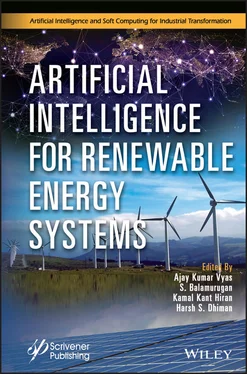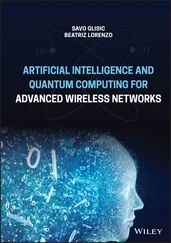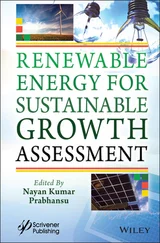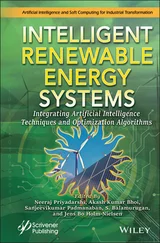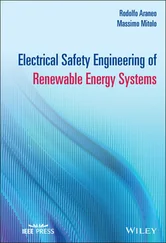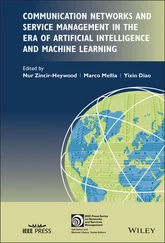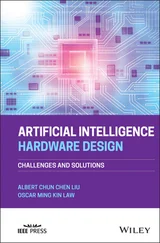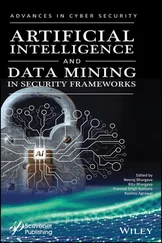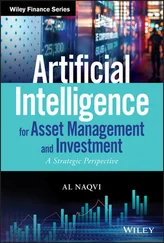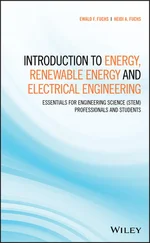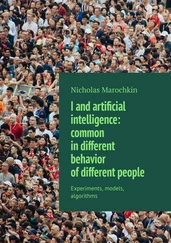Artificial Intelligence for Renewable Energy Systems
Здесь есть возможность читать онлайн «Artificial Intelligence for Renewable Energy Systems» — ознакомительный отрывок электронной книги совершенно бесплатно, а после прочтения отрывка купить полную версию. В некоторых случаях можно слушать аудио, скачать через торрент в формате fb2 и присутствует краткое содержание. Жанр: unrecognised, на английском языке. Описание произведения, (предисловие) а так же отзывы посетителей доступны на портале библиотеки ЛибКат.
- Название:Artificial Intelligence for Renewable Energy Systems
- Автор:
- Жанр:
- Год:неизвестен
- ISBN:нет данных
- Рейтинг книги:5 / 5. Голосов: 1
-
Избранное:Добавить в избранное
- Отзывы:
-
Ваша оценка:
- 100
- 1
- 2
- 3
- 4
- 5
Artificial Intelligence for Renewable Energy Systems: краткое содержание, описание и аннотация
Предлагаем к чтению аннотацию, описание, краткое содержание или предисловие (зависит от того, что написал сам автор книги «Artificial Intelligence for Renewable Energy Systems»). Если вы не нашли необходимую информацию о книге — напишите в комментариях, мы постараемся отыскать её.
Renewable energy systems, including solar, wind, biodiesel, hybrid energy, and other relevant types, have numerous advantages compared to their conventional counterparts. This book presents the application of machine learning and deep learning techniques for renewable energy system modeling, forecasting, and optimization for efficient system design.
Audience
Artificial Intelligence for Renewable Energy Systems — читать онлайн ознакомительный отрывок
Ниже представлен текст книги, разбитый по страницам. Система сохранения места последней прочитанной страницы, позволяет с удобством читать онлайн бесплатно книгу «Artificial Intelligence for Renewable Energy Systems», без необходимости каждый раз заново искать на чём Вы остановились. Поставьте закладку, и сможете в любой момент перейти на страницу, на которой закончили чтение.
Интервал:
Закладка:
Table of Contents
1 Cover
2 Title Page
3 Copyright
4 Preface
5 1 Analysis of Six-Phase Grid Connected Synchronous Generator in Wind Power Generation 1.1 Introduction 1.2 Analytical Modeling of Six-Phase Synchronous Machine 1.3 Linearization of Machine Equations for Stability Analysis 1.4 Dynamic Performance Results 1.5 Stability Analysis Results 1.6 Conclusions References Appendix Symbols Meaning
6 2 Artificial Intelligence as a Tool for Conservation and Efficient Utilization of Renewable Resource 2.1 Introduction 2.2 AI in Water Energy 2.3 AI in Solar Energy 2.4 AI in Wind Energy 2.5 AI in Geothermal Energy 2.6 Conclusion References
7 3 Artificial Intelligence–Based Energy-Efficient Clustering and Routing in IoT-Assisted Wireless Sensor Network 3.1 Introduction 3.2 Related Study 3.3 Clustering in WSN 3.4 Research Methodology 3.5 Conclusion References
8 4 Artificial Intelligence for Modeling and Optimization of the Biogas Production 4.1 Introduction 4.2 Artificial Neural Network 4.3 Evolutionary Algorithms 4.4 Conclusion References
9 5 Battery State-of-Charge Modeling for Solar PV Array Using Polynomial Regression 5.1 Introduction 5.2 Dynamic Battery Modeling 5.3 Results and Discussion 5.4 Conclusion References
10 6 Deep Learning Algorithms for Wind Forecasting: An Overview Nomenclature 6.1 Introduction 6.2 Models for Wind Forecasting 6.3 The Deep Learning Paradigm 6.4 Deep Learning Approaches for Wind Forecasting 6.5 Research Challenges 6.6 Conclusion References
11 7 Deep Feature Selection for Wind Forecasting-I 7.1 Introduction 7.2 Wind Forecasting System Overview 7.3 Current Forecasting and Prediction Methods 7.4 Deep Learning–Based Wind Forecasting 7.5 Case Study References
12 8 Deep Feature Selection for Wind Forecasting-II 8.1 Introduction 8.2 Literature Review 8.3 Long Short-Term Memory Networks 8.4 Gated Recurrent Unit 8.5 Bidirectional Long Short-Term Memory Networks 8.6 Results and Discussion 8.7 Conclusion and Future Work References
13 9 Data Falsification Detection in AMI: A Secure Perspective Analysis 9.1 Introduction 9.2 Advanced Metering Infrastructure 9.3 AMI Attack Scenario 9.4 Data Falsification Attacks 9.5 Data Falsification Detection 9.6 Conclusion References
14 10 Forecasting of Electricity Consumption for G20 Members Using Various Machine Learning Techniques 10.1 Introduction 10.2 Dataset Preparation 10.3 Results and Discussions 10.4 Conclusion Acknowledgement References
15 11 Use of Artificial Intelligence (AI) in the Optimization of Production of Biodiesel Energy 11.1 Introduction 11.2 Indian Perspective of Renewable Biofuels 11.3 Opportunities 11.4 Relevance of Biodiesel in India Context 11.5 Proposed Model 11.6 Conclusion References
16 Index
17 End User License Agreement
List of Illustrations
1 Chapter 1 Figure 1.1 Equivalent circuit representation of a six-phase synchronous machine. Figure 1.2 Dynamic response of motor following the change in load torque showing... Figure 1.3 Dynamic response of motor following the change in load torque showing... Figure 1.4 d-q component of stator winding currents (a) Iq 1, (b) Id 1, (c) Iq 2, a... Figure 1.5 Variation in eigenvalue of three-phase synchronous machine with stato... Figure 1.6 Variation in eigenvalue of six-phase synchronous machine with stator ... Figure 1.7 Variation in eigenvalue of three-phase synchronous machine with stato... Figure 1.8 Variation in eigenvalue of six-phase synchronous machine with stator ... Figure 1.9 Variation in eigenvalue of three-phase synchronous machine with field... Figure 1.10 Variation in eigenvalue of six-phase synchronous machine with field ... Figure 1.11 Variation in eigenvalue of three-phase synchronous machine with fiel... Figure 1.12 Variation in eigenvalue of six-phase synchronous machine with field ... Figure 1.13 Variation in eigenvalue of three-phase synchronous machine with damp... Figure 1.14 Variation in eigenvalue of six-phase synchronous machine with damper... Figure 1.15 Variation in eigenvalue of three-phase synchronous machine with damp... Figure 1.16 Variation in eigenvalue of six-phase synchronous machine with damper... Figure 1.17 Variation in eigenvalue of three-phase synchronous machine with damp... Figure 1.18 Variation in eigenvalue of six-phase synchronous machine with damper... Figure 1.19 Variation in eigenvalue II with damper leakage reactance change alon... Figure 1.20 Variation in eigenvalue of three-phase synchronous machine with magn... Figure 1.21 Variation in eigenvalue of six-phase synchronous machine with magnet... Figure 1.22 Change in real/real component of generator eigenvalue due to load va...
2 Chapter 2 Figure 2.1 Radial basis neural network architecture. Reprint with copyright perm... Figure 2.2 Back-propagation architecture. Reprint with copyright permission from... Figure 2.3 Feed-forward neural network architecture. Reprint with copyright perm...Figure 2.4 Cascaded systems of neural networks (ISSO). Reprint with copyright pe...Figure 2.5 ANN-based condition monitoring method using SCADA data. Reprint with ...Figure 2.6 Procedure for Artificial Bee Colony (ABC) algorithm. Reprint with per...
3 Chapter 3Figure 3.1 Clustered WSNs.
4 Chapter 4Figure 4.1 Principal of biogas generation.Figure 4.2 Biogas generation plant at the LNMIIT, Jaipur.Figure 4.3 Basic artificial neural network architecture.Figure 4.4 Feedback propagation artificial neural network.Figure 4.5 Genetic algorithm evaluation flow.Figure 4.6 Path of ant when there is an obstruction.Figure 4.7 Ant colony optimization.Figure 4.8 Swarm of birds [30].Figure 4.9 Flowchart of particle swarm optimization.
5 Chapter 5Figure 5.1 First-order battery model.Figure 5.2 Block diagram for the simulation setup.Figure 5.3 I-V and P-V curve for solar PV array.Figure 5.4 Irradiance, current, voltage, and SoC for the simulation setup.Figure 5.5 Curve fitting for OCV-SoC based on second-, third-, 4, and fifth-orde...
6 Chapter 6Figure 6.1 Classification of WPF models.Figure 6.2 Wind forecasting methodologies.Figure 6.3 Deep learning paradigm.Figure 6.4 Deep learning approaches for WPF.
7 Chapter 7Figure 7.1 (a) Total installed wind capacity around the world. (b) Total install...Figure 7.2 Components of wind energy conversion system.Figure 7.3 Wind power characteristics curve.Figure 7.4 Classification of wind energy technologies.Figure 7.5 Wind forecasting system [4].Figure 7.6 General forecasting framework.Figure 7.7 Classification of statistical methods.Figure 7.8 Classification of time series method.Figure 7.9 Multilayer feed-forward network.Figure 7.10 One-level decomposition.Figure 7.11 Wavelet tree decomposition with three detailed levels.Figure 7.12 Architecture of ANFIS network.Figure 7.13 Hyperplane SVM architecture.Figure 7.14 Architecture of Kernel-type SVM.Figure 7.15 Flowchart depicting data pre-processing.Figure 7.16 Different network architectures used in deep learning.Figure 7.17 Unsupervised pre-trained network architecture.Figure 7.18 Deep CNN architecture.Figure 7.19 RNN architecture.Figure 7.20 Support vector machine network structure.Figure 7.21 Prediction comparisons between various models.Figure 7.22 Daily variation of averaged wind speed.Figure 7.23 Structure of the proposed ANN model.Figure 7.24 Comparison between the measured and predicted wind speed.
8 Chapter 8Figure 8.1 LSTM with four interacting layers.Figure 8.2 No. of epochs vs. loss.Figure 8.3 Actual and predicted test value.Figure 8.4 Visualization over full data.Figure 8.5 Plot over small part of the data.Figure 8.6 Plot over very small part of the data.Figure 8.7 GRU.Figure 8.8 Number of epochs vs. loss.Figure 8.9 Plot of actual and predicted test value.Figure 8.10 Visualization over full data.Figure 8.11 Plot over the small part of the data.Figure 8.12 Plot over very small part of data.Figure 8.13 Bidirectional LSTM.Figure 8.14 No. of epoch vs. loss.Figure 8.15 Actual and predicted test value.Figure 8.16 Visualization over full data.Figure 8.17 Plot over small part of the data.Figure 8.18 Plot over very small part of the data.
Читать дальшеИнтервал:
Закладка:
Похожие книги на «Artificial Intelligence for Renewable Energy Systems»
Представляем Вашему вниманию похожие книги на «Artificial Intelligence for Renewable Energy Systems» списком для выбора. Мы отобрали схожую по названию и смыслу литературу в надежде предоставить читателям больше вариантов отыскать новые, интересные, ещё непрочитанные произведения.
Обсуждение, отзывы о книге «Artificial Intelligence for Renewable Energy Systems» и просто собственные мнения читателей. Оставьте ваши комментарии, напишите, что Вы думаете о произведении, его смысле или главных героях. Укажите что конкретно понравилось, а что нет, и почему Вы так считаете.
